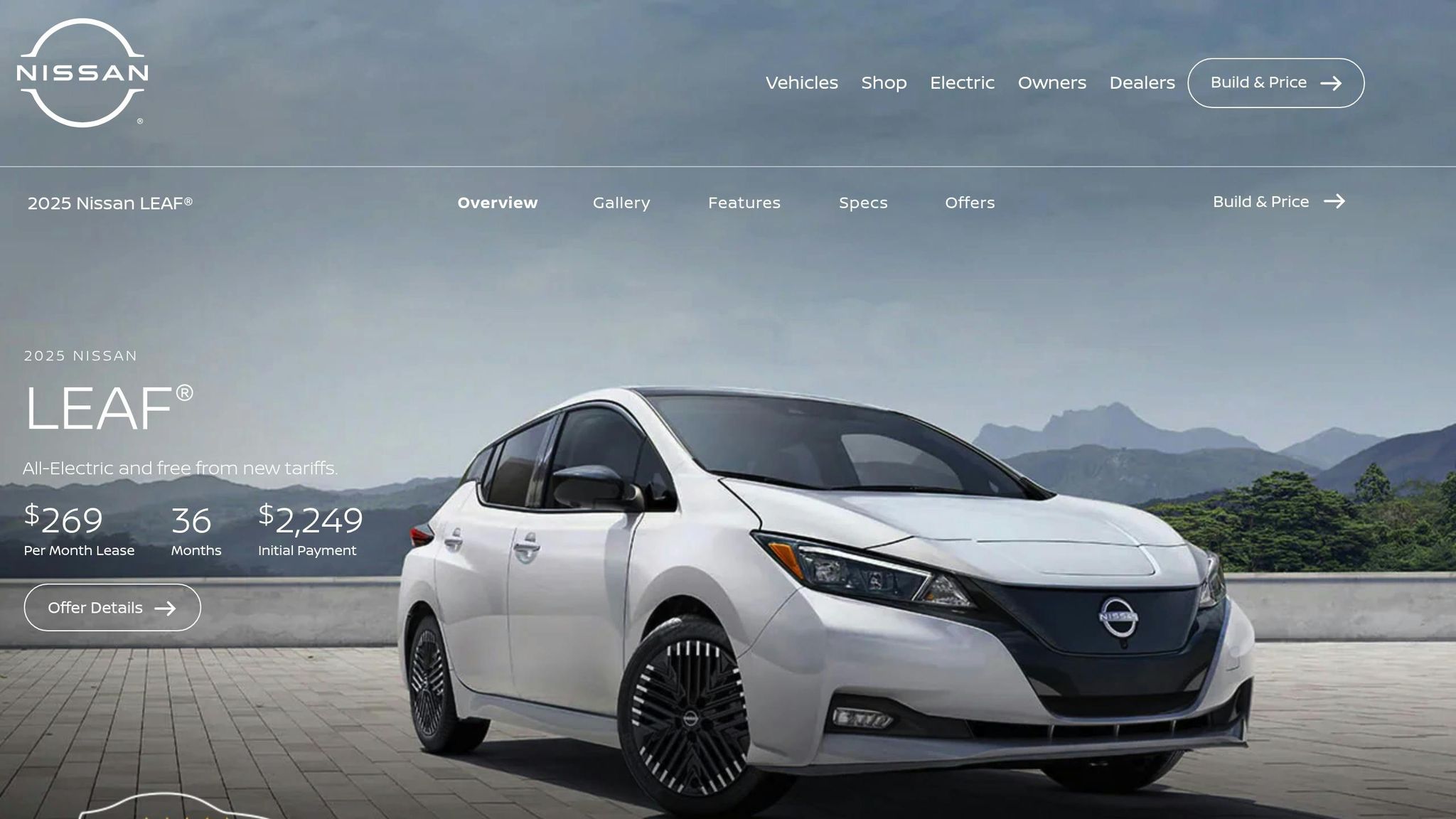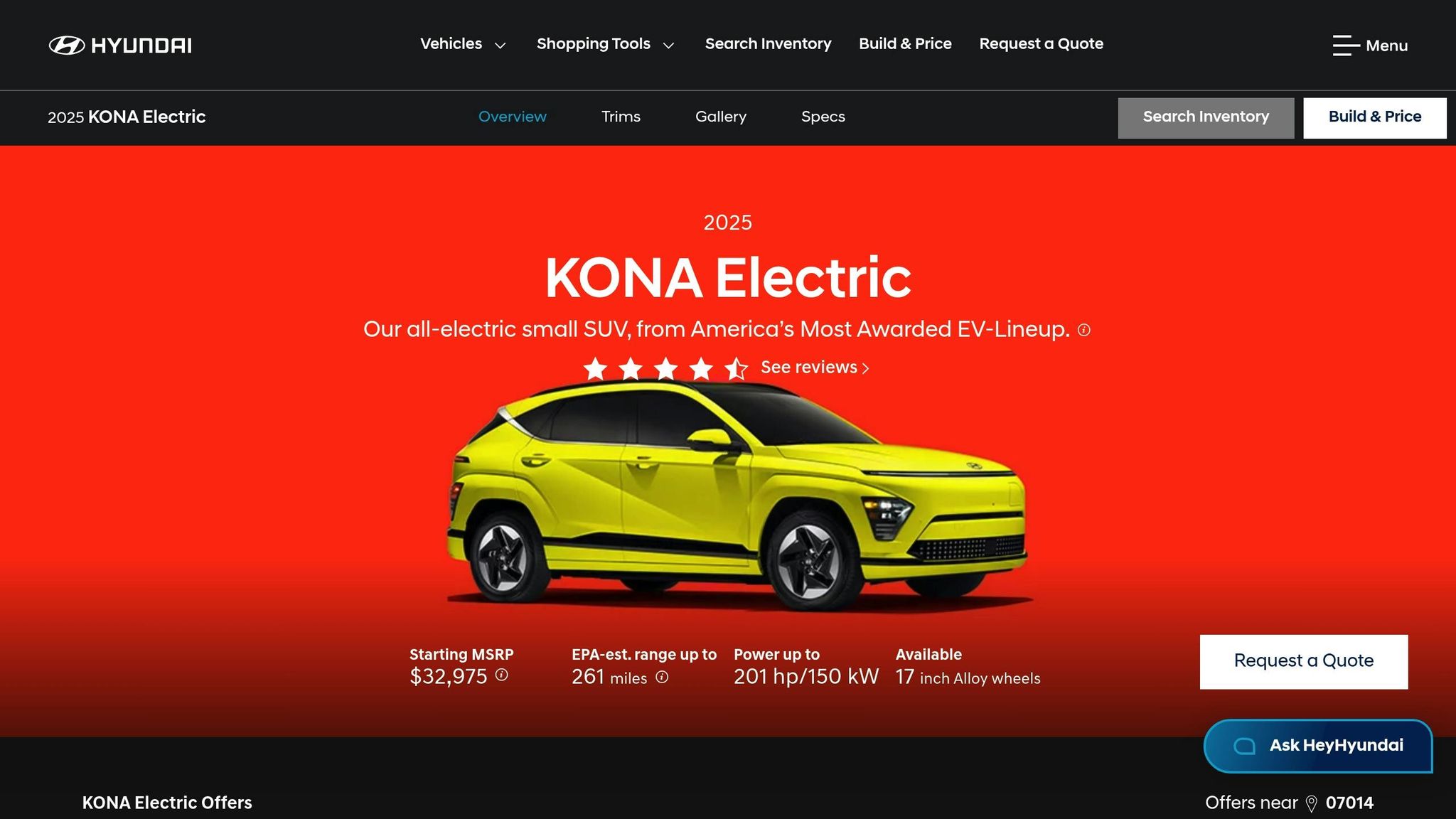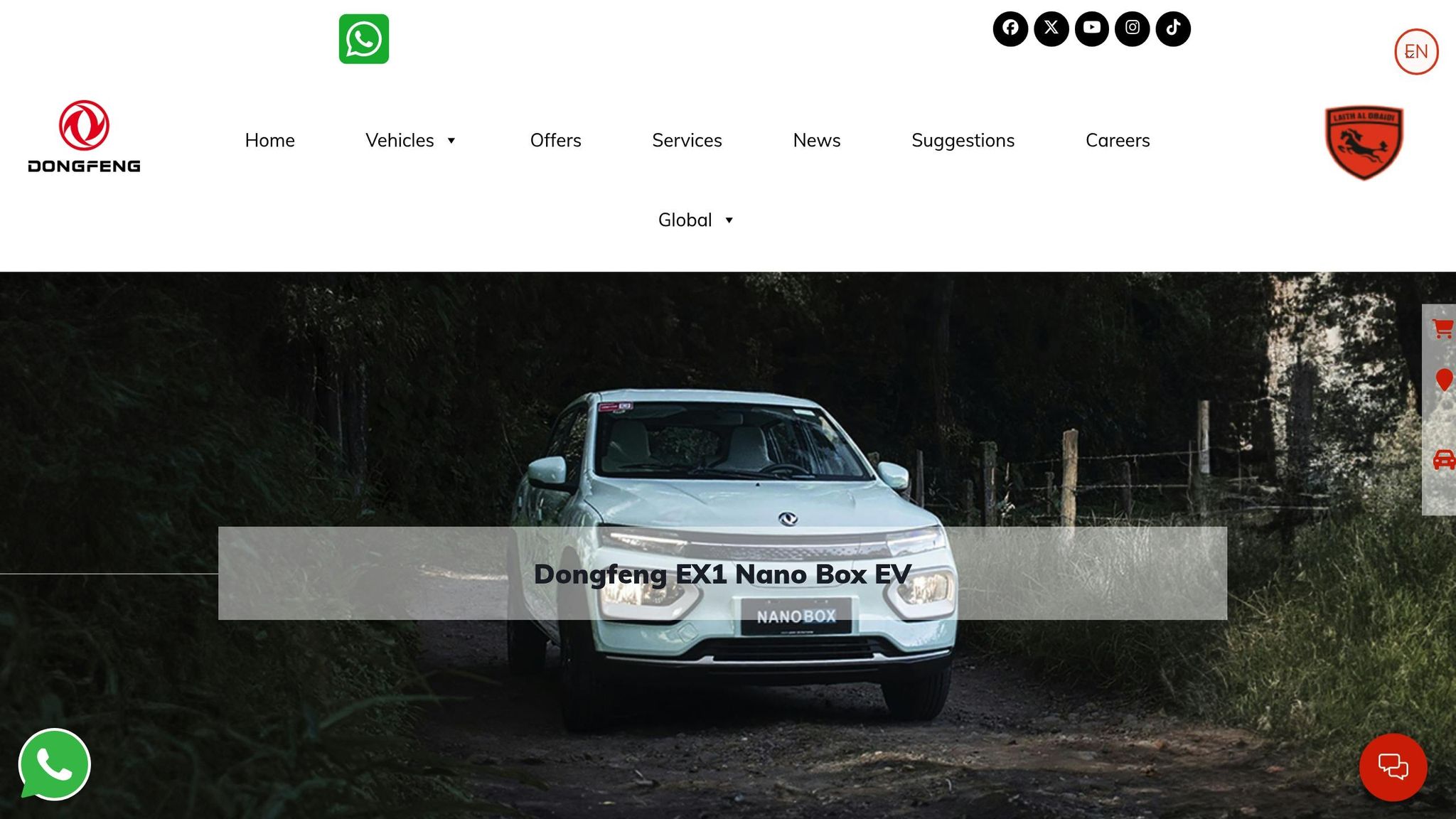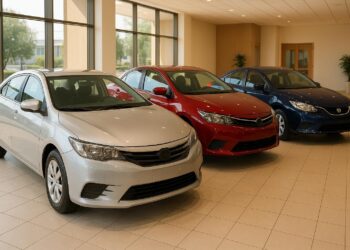Electric cars are becoming more popular in Kenya, with sales up 150% in 2025. This growth is driven by tax cuts, better charging infrastructure, and a push for greener transportation. Here’s what you need to know:
- Top Models Available: Nissan Leaf, BYD Yuan Plus (Atto 3), Hyundai Kona Electric, Dongfeng EX1 Nano Box, and the EV Explorers Off-road EV.
- Prices: Range from $6,500 (Dongfeng EX1 Nano Box) to $31,000 (Hyundai Kona Electric).
- Charging Stations: Over 200 stations available, with plans for 10,000 by 2030.
- Government Support: Reduced import duties and no VAT on EVs make them more affordable.
Quick Comparison Table:
| Model | Price Range (USD) | Range (Miles) | Charging Time | Best For |
|---|---|---|---|---|
| Nissan Leaf | $7,200–$12,000 | 149–212 | 3 hours (L2) | City & intercity |
| BYD Yuan Plus (Atto 3) | ~$20,000 | 261–304 | 15 min (fast) | Urban & highways |
| Hyundai Kona Electric | $26,000–$31,000 | 200–261 | 43 min (fast) | Families & long trips |
| Dongfeng EX1 Nano Box | $6,500–$6,800 | 155–206 | ~4 hours (AC) | Budget city driving |
| EV Explorers Off-road EV | N/A | N/A | N/A | Off-road adventures |
Kenya’s EV market is growing fast, making it a great time to consider switching to electric. Whether you’re looking for an affordable city car or a premium family EV, there’s an option for you.
Kenya’s EV Market is EXPLODING in 2025! Here’s What You Should Know ⚡
1. Nissan Leaf

The Nissan Leaf has carved out a spot in Kenya’s growing EV market, offering a blend of practicality and affordability. As one of the more established electric cars in the region, it continues to attract attention for its performance and cost-effectiveness.
Price (USD)
For those considering a used 2016 Nissan Leaf, prices in Kenya range between KSh 1,250,000 and KSh 1,300,000 (approximately $9,500–$9,900). If you’re looking at direct imports, auction prices for used models (CIF Mombasa) have varied from KSh 943,044 to KSh 1,576,368 (roughly $7,200–$12,000) as of May 2025. On the other hand, the 2025 Nissan Leaf is priced at $29,280–$37,330 in the U.S. market. However, no new models appear to be available in Kenya at this time.
Range (mi/km)
The Nissan Leaf comes with two battery options: a 40 kWh battery with a range of 149 miles (240 km) and a 60 kWh battery offering 212 miles (341 km). In a 2022 test, a 62 kWh Leaf managed to cover 215 miles (345.5 km), finishing with 11% battery and an estimated 34 miles (55 km) still available. This makes it a solid choice for both city commutes and intercity travel. Additionally, the Leaf’s "e-Pedal" feature helps regenerate energy during city driving and on downhill stretches, further boosting its efficiency.
Charging Time
Charging a Nissan Leaf in Kenya is relatively straightforward. Most of the available charging stations use Level 2 chargers, which take about 3 hours to fully charge the vehicle. For those in need of faster solutions, 80kW DC fast chargers – introduced by Chinese e-mobility companies in Nairobi – can recharge an EV in as little as 15 to 30 minutes.
Suitability for Kenyan Roads
The Nissan Leaf is well-suited for Kenya’s diverse road conditions. Its compact design makes it perfect for navigating Nairobi’s bustling traffic, while its performance on the Kisumu-to-Nairobi route proves its ability to handle longer journeys. The regenerative braking system is a bonus, especially in hilly areas and stop-and-go traffic. With its affordability, range, and versatility, the Leaf stands out as a practical option in Kenya’s emerging EV market.
2. BYD Yuan Plus (Atto 3)

The BYD Atto 3, offered by Topcar Kenya, highlights the strides in Chinese automotive technology. Built on the BYD e-Platform 3.0, it is designed to deliver better efficiency, improved safety features, and a smooth driving experience.
Price (USD)
To get the latest pricing, visit www.dealer.co.ke or consult local dealers. Keep in mind that import costs are influenced by the Kenya Revenue Authority‘s updated Current Retail Selling Price (CRSP) list, which came into effect on July 1, 2025. This update impacts import duty, VAT, and excise duty calculations.
Range (mi/km)
The Atto 3 offers three battery configurations: 49.92 kWh, 50.25 kWh, and 60.48 kWh. The largest battery delivers a WLTP range of about 261 miles (420 km). For city driving in mild weather, the range can stretch to 304 miles (490 km), but highway driving in colder conditions reduces it to around 146 miles (235 km).
Quick charging is another highlight – just 15 minutes of charging can provide an average of 202 miles (325 km). However, its long-distance suitability is rated at 2/5.
Charging Time
The Atto 3 supports DC fast charging, which is increasingly convenient thanks to Kenya’s growing charging infrastructure.
Suitability for Kenyan Roads
Equipped with the advanced e-Platform 3.0, the Atto 3 is built to handle Kenya’s diverse road conditions. It performs well in urban settings and on intercity routes, offering solid driving dynamics. While spare parts are generally accessible, body parts may be more challenging to find. That said, the vehicle’s 5-star Euro NCAP rating underscores its robust build quality .
3. Hyundai Kona Electric

The Hyundai Kona Electric brings together modern features and a well-thought-out design. This compact crossover SUV combines practicality with the efficiency of electric power, making it an appealing option for those looking for a dependable and comfortable EV.
Price (USD)
The Kona Electric is priced between approximately KES 3.5 million and KES 4.2 million, which translates to around $26,000–$31,000. Thanks to recent cuts in import duty and excise tax, it has become more accessible to buyers. Now, let’s take a closer look at its range capabilities across different trims.
Range (mi/km)
For the 2025 model, the Kona Electric offers EPA-estimated ranges that vary by trim level: about 200 miles for the SE, 261 miles for the SEL and Limited trims, and 230 miles for the N Line. In real-world tests, the 65 kWh model achieved around 240 miles at 68°F (20°C), with energy consumption at 273 Wh/mile – equivalent to about 148 mpg when compared to a gasoline-powered car. However, driving conditions can significantly influence range. For example, gentle city driving might stretch the range to roughly 360 miles (579 km), while colder highway conditions could lower it to around 170 miles (274 km).
Charging Time
The Kona Electric also shines when it comes to charging efficiency. It supports DC fast charging, allowing you to recharge from 10% to 80% in just about 43 minutes using a 400V DC fast charger. Its 65.4 kWh usable battery capacity ensures enough power for daily drives and even longer road trips across Kenya.
Suitability for Kenyan Roads
With its small crossover SUV design, the Kona Electric offers higher ground clearance compared to standard sedans, making it a good fit for both city streets and rural terrain. Its quiet electric motor and smooth ride enhance the driving experience on various road types. However, its steering feedback might feel less engaging on winding roads . This mix of comfort and capability positions the Kona Electric as a smart choice in Kenya’s growing EV market.
sbb-itb-e5ed0ed
4. Dongfeng EX1 Nano Box

The Dongfeng EX1 Nano Box stands out as a budget-friendly option in Kenya’s growing electric vehicle market. Designed as a compact city car, it appeals to urban drivers looking for an efficient and economical way to navigate city streets.
Price (USD)
According to the Kenya Revenue Authority’s CRSP, the Nano Box is priced at KSh 1,583,128 (around $11,800). However, retail prices typically range between $6,500 and $6,800, depending on dealer markups and taxes. Let’s take a closer look at its performance in terms of range.
Range (mi/km)
Powered by a 27.2 kWh battery, the Nano Box offers a CLTC range of approximately 331 km (206 miles). However, in everyday driving conditions – factoring in air conditioning use and stop-and-go traffic – the range is closer to 250 km (155 miles). With a top speed of 100 km/h (62 mph), it’s well-suited for both city commutes and occasional highway trips. Some users have even reported achieving real-world ranges of 301 to 331 km per charge, showcasing its dependable performance.
Charging Time
The Nano Box features a 6.6 kW AC charging system, allowing it to go from 50% to 95% charge in about 4 hours. This makes it convenient for overnight or workplace charging, catering to urban drivers who need quick turnaround times.
Suitability for Kenyan Roads
With a ground clearance of 150 mm (5.9 inches), the Nano Box is designed for smooth, paved urban roads. Its compact size – measuring 3,732 mm in length, 1,579 mm in width, and 1,515 mm in height – makes it easy to navigate through crowded streets and tight parking spaces, a big plus in cities like Nairobi. The suspension system, which includes Macpherson struts in the front and a torsion beam in the rear, ensures a comfortable ride, especially in city environments.
"I was searching for an environmentally friendly vehicle that could maneuver easily in tight city spaces" – Nathalie, Dongfeng Nano Box Owner
With a 4/5 user rating, the Nano Box has won praise for its practicality as an urban electric vehicle. However, its lower ground clearance makes it better suited for well-maintained, paved roads rather than rough or unpaved terrain.
5. EV Explorers Off-road EV
The EV Explorers Off-road EV made history as the first electric vehicle to compete in Kenya’s Rhino Charge, an off-road motorsport event with a 35-year legacy.
Suitability for Kenyan Roads
Led by Richard Kiplagat and Nick Foley, the EV Explorers team showcased how electric vehicles can perform in some of the toughest terrains during the Rhino Charge. This achievement highlights the potential of EVs to handle Kenya’s diverse and demanding landscapes.
"The team aimed to demonstrate the link between climate action and conservation." – Richard Kiplagat, EV Explorers team leader
"Proving EV viability in rugged conditions could inspire further innovation in sustainable transport technologies." – Nick Foley, Engineer
Built to tackle rocky paths and muddy trails, this off-road EV is designed to excel in Kenya’s varied environments. Supported by key organizations like Africa Practice, KenGen, and Safaricom, the project underscores how sustainable transport can thrive even under extreme conditions. Its participation in the Rhino Charge, which has raised over $18.56 million for conservation projects, serves as a powerful example of the intersection between innovation and environmental stewardship.
Advantages and Disadvantages
Let’s break down the key advantages and challenges of Kenya’s electric vehicle (EV) market. Each EV model available has its own strengths and weaknesses, which can influence its suitability for different driving conditions and budgets. Understanding these trade-offs is essential for making an informed choice.
Cost considerations play a huge role for many Kenyan buyers. For instance, the Dongfeng EX1 Nano Box stands out as the most affordable option, priced at KSh 1,583,128. While its low price makes it attractive for budget-conscious consumers, it does come with trade-offs like a shorter range and fewer features. On the other end of the spectrum, the Hyundai Kona Electric offers impressive build quality and a longer range but comes with a steeper price tag, ranging from KSh 3,500,000 to KSh 4,200,000.
When it comes to operating costs, EVs have a clear edge. Charging an EV costs about KSh 5 per kilometer, significantly less than the KSh 12 per kilometer for gasoline vehicles. Plus, with fewer moving parts, EVs generally require less maintenance. These savings add up over time, making EVs appealing for those looking to cut long-term expenses.
Road performance is another factor to consider. Models like the BYD Yuan Plus and Hyundai Kona Electric are designed with higher ground clearance and sturdy suspension systems, making them better suited for Nairobi’s unpredictable roads and occasional rural drives. On the other hand, compact models like the older Nissan Leaf (2014–2017) excel in city driving but may struggle on rougher terrain.
However, range anxiety remains a pressing concern. While premium models tend to offer better battery capacity and longer ranges, many buyers worry about the limited charging infrastructure in Kenya. This makes range a critical factor, especially for those planning longer trips. Fortunately, ongoing investments in charging stations aim to address this issue over time.
| Model | Price Range (KSh) | Main Advantage | Key Limitation |
|---|---|---|---|
| Dongfeng EX1 Nano Box | 1,583,128 | Most affordable option | Limited range/features |
| Nissan Leaf (2014–2017) | 1,200,000 – 1,700,000 | Reliable and proven | Outdated technology |
| BYD Yuan Plus | 2,500,000 – 2,800,000 | Excellent ground clearance | Mid-range pricing |
| Hyundai Kona Electric | 3,500,000 – 4,200,000 | High build quality | Most expensive option |
Charging infrastructure is a challenge for all EV owners in Kenya. While the government has introduced incentives like reduced import duties and excise taxes to encourage EV adoption, the limited number of public charging stations means many owners rely on home charging. While this setup works well for daily commutes, it requires careful planning for longer trips.
Government policies are also shaping the EV landscape. While the Kenya Revenue Authority’s updated pricing list, effective July 1, 2025, is expected to push up vehicle costs, there’s growing concern about the potential removal of lithium batteries from the zero-rated VAT category. Such changes could increase EV ownership costs.
Despite these challenges, the market is growing rapidly. Kenya’s EV market expanded by 108% during the 2022–2023 financial year, and the government aims for EVs to make up 5% of all new vehicle registrations by 2025. This growth is likely to improve service networks, spare parts availability, and even resale values in the near future.
Lastly, Kenya’s climate is a natural fit for EVs. Unlike regions with extreme weather, which can affect battery performance, Kenya’s moderate temperatures allow EVs to operate efficiently throughout the year. This, combined with the market’s promising growth, highlights the potential for EV adoption in Kenya.
Final Thoughts
As Kenya’s electric vehicle (EV) market continues to grow, there’s an expanding range of options to suit different lifestyles and budgets. Whether you’re looking for affordability, practicality, or premium features, there’s likely an EV that fits your needs.
For buyers keeping an eye on their wallets, the Nissan Leaf (2014–2017) offers a budget-friendly entry into the world of electric driving. With prices ranging between KSh 1,200,000 and KSh 1,700,000, it’s a solid choice for those wanting to make the switch without breaking the bank.
Urban commuters might lean toward the BYD Yuan Plus (Atto 3), which combines modern features with affordability. Plus, its decent ground clearance makes it well-suited for navigating Nairobi’s roads. The savings on fuel costs compared to petrol-powered cars make it a practical pick for daily city driving.
For families or drivers seeking a touch of luxury, the Hyundai Kona Electric delivers. With its extended range, high-quality build, and comfortable ride, it’s an excellent option for those who prioritize premium features.
When deciding, think about your daily driving habits and access to charging. If you have home charging capabilities, you’ll enjoy added convenience, especially for urban driving. On the other hand, if your routes include longer rural trips, prioritize models with a more extended range. Don’t forget to budget for extras like home charger installation and routine battery maintenance. For those considering used EVs, always ask for a battery health report to avoid costly surprises later.
With government incentives, expanding charging infrastructure, and long-term savings on fuel and maintenance, now is an exciting time to embrace electric driving in Kenya.
FAQs
What are the key benefits of driving an electric car in Kenya?
Switching to an electric vehicle (EV) in Kenya comes with some great perks. One of the biggest is lower running costs. Charging an EV is much cheaper than fueling a gas-powered car, and since EVs have fewer moving parts, maintenance costs are noticeably lower too.
Another major advantage is how EVs support a cleaner environment. They produce zero tailpipe emissions, which means less air pollution – something that aligns perfectly with Kenya’s push for greener, healthier cities. Plus, since Kenya relies heavily on renewable energy sources like geothermal and hydropower, EVs here are even more environmentally friendly.
Making the switch to electric mobility not only saves you money but also plays a part in building a cleaner, more sustainable future for Kenya.
What is the current state of electric vehicle charging infrastructure in Kenya, and what are the plans for future expansion?
Kenya’s network of electric vehicle (EV) charging stations is expanding rapidly. By mid-2024, drivers already have access to over 100 charging stations, with plans to add about 45 more across various counties within the next year.
The government has set its sights on an ambitious target: establishing 10,000 charging stations by 2030. This includes 700 stations in urban centers and 300 strategically placed along major highways. These efforts are geared toward making EVs a more practical choice for drivers and advancing Kenya’s shift toward cleaner, more sustainable transportation.
What should I keep in mind when selecting an electric car for Kenya’s unique road conditions?
When selecting an electric car for Kenya’s diverse road conditions, prioritize ground clearance and suspension to navigate uneven or rugged terrain. A sturdy build is equally important to handle the challenges posed by various environments.
It’s also crucial to think about the availability of charging stations in your region and the vehicle’s energy efficiency. These factors will directly influence your convenience and overall running costs. If charging infrastructure is limited in your area, hybrid models – offering both electric and fuel-based systems – can be a smart option. On the other hand, fully electric vehicles are ideal for urban areas where charging facilities are more dependable.
Related posts
- Guide to Electric Vehicle Charging Stations in Kenya
- Top Fuel-Efficient Cars for Long-Distance Drives in Kenya
- Top 5 Automotive Trade Fairs in Kenya 2025
- Car prices in Nairobi 2025




